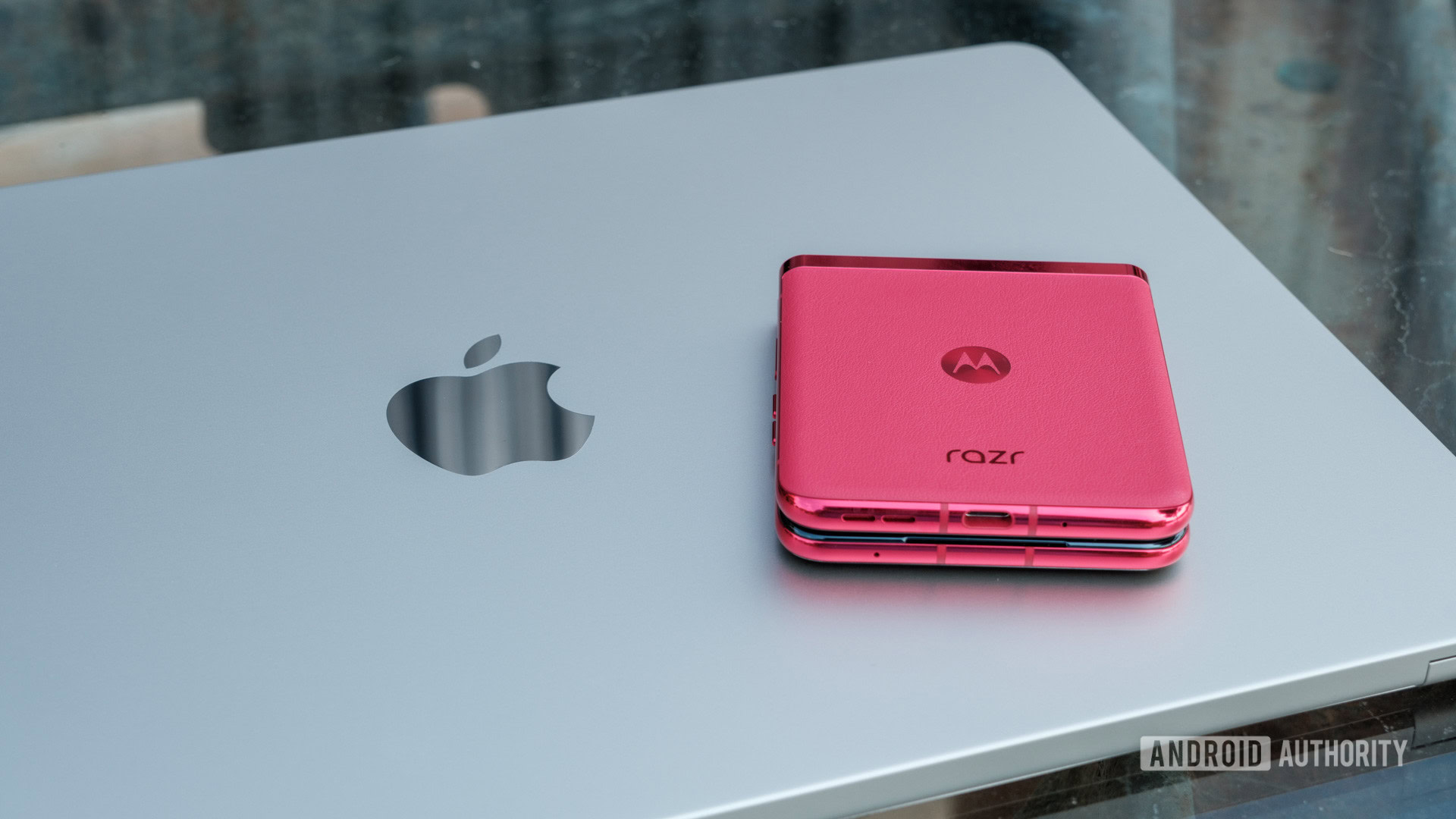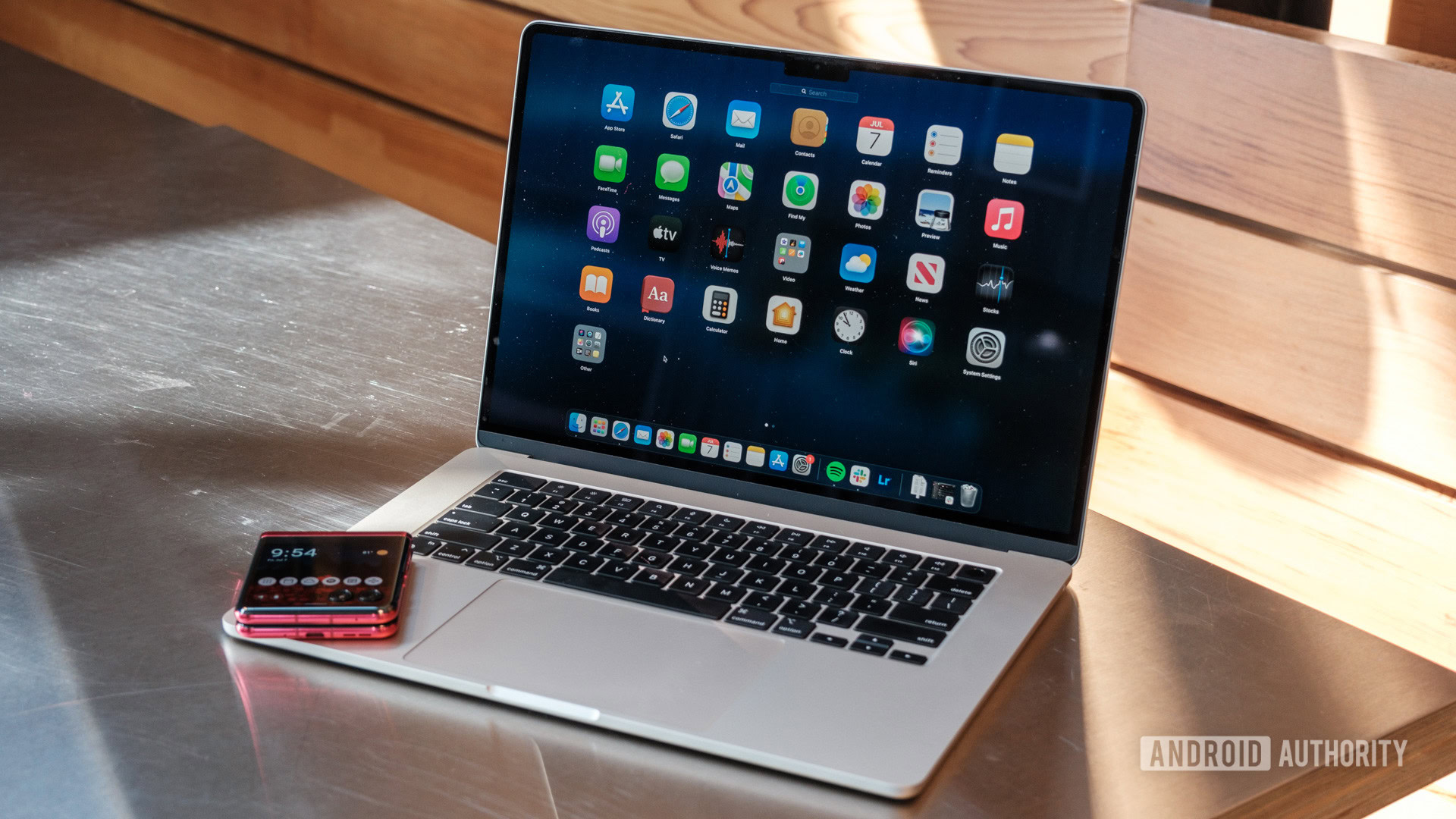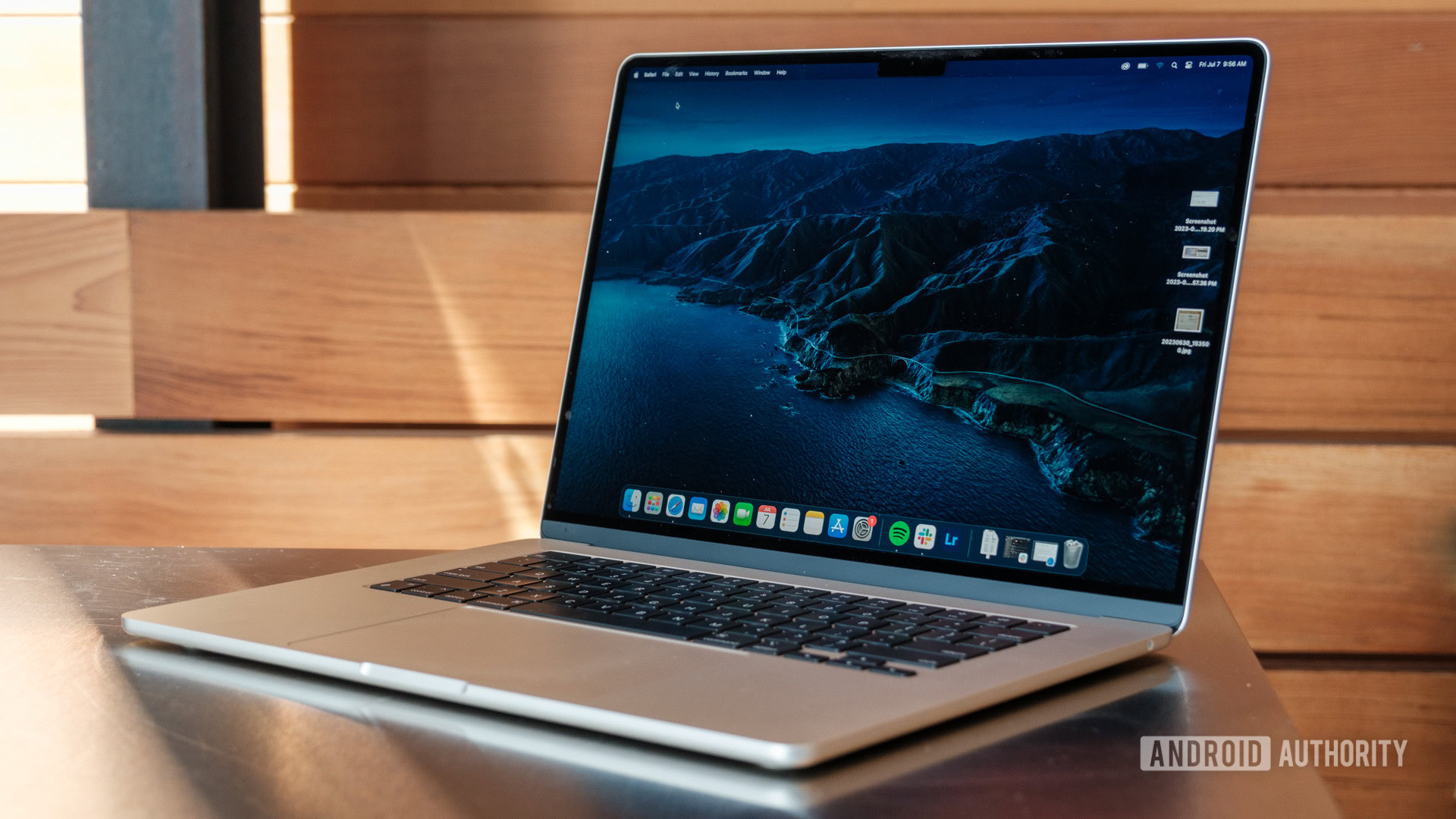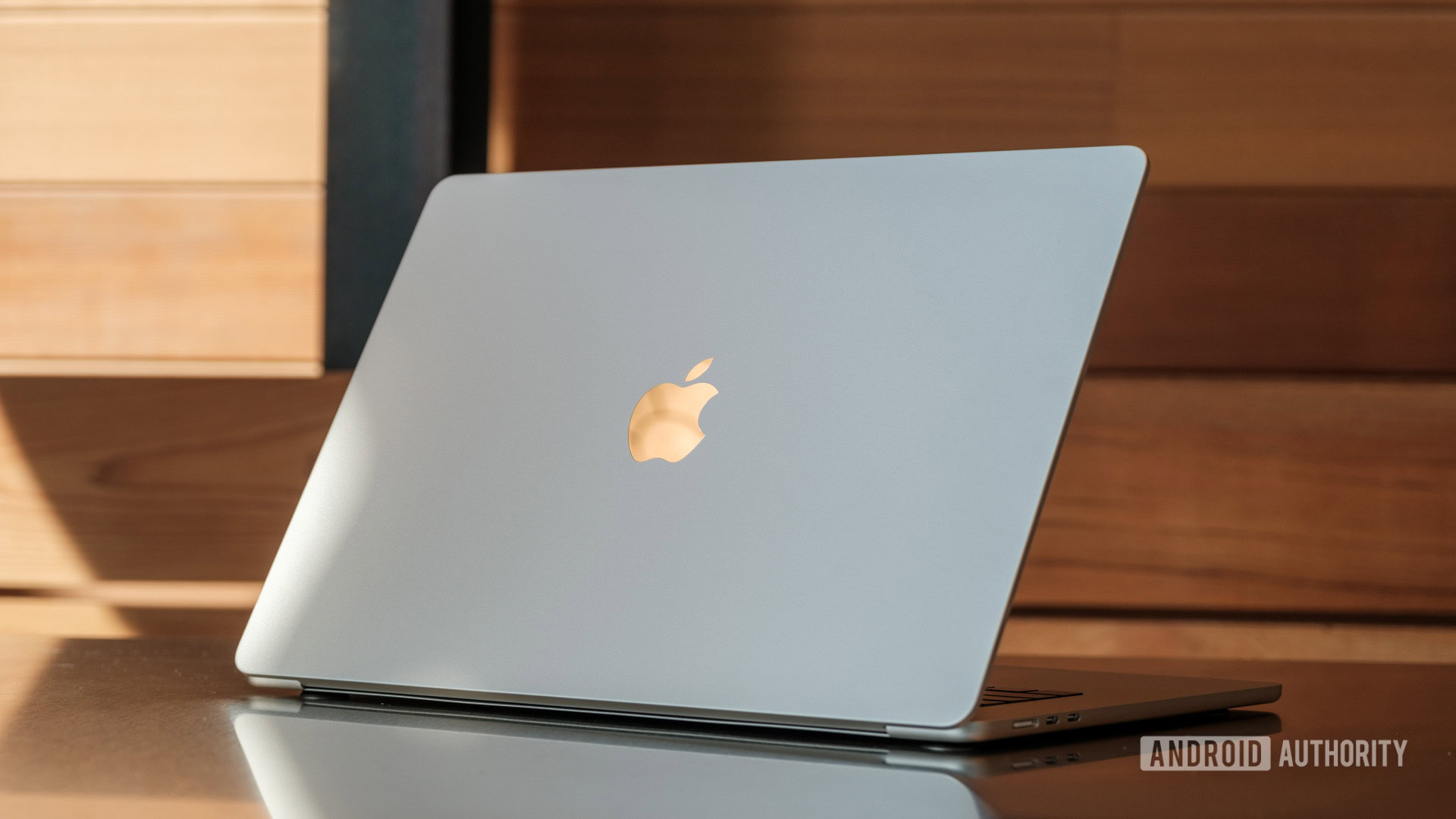Affiliate links on Android Authority may earn us a commission. Learn more.
Can a MacBook Air fit into an Android addict's lifestyle?
Published onJuly 9, 2023

It’s easy to find yourself drawn into a mobile ecosystem without thinking about it. Samsung users are pretty content with their expansive Galaxy, Pixel users are closer to a complete setup than ever, and Apple users, well, we all know how Apple’s walled garden locks you in as much as it locks others out. What happens when you dabble in different ecosystems to get the best of multiple worlds? What happens when you introduce the newest 15-inch version of the M2-powered MacBook Air into a staunch Android user’s personal and work life? I upgraded my laptop to find out.
Double? Or nothing?

I’ve set up enough Samsung Galaxy devices that duplicate apps don’t phase me anymore. It takes only a few seconds to relegate Samsung’s messages app and internet browser to a folder I’ll never open again. However, I quickly found that bridging the gap from an Android phone to a MacBook was going to be a little tougher. You’re in Apple territory now, and the Cupertino-based brand would sure like to steer you toward its in-house options for email, maps, and more — much like if you were setting up a new iPhone.
The bigger problem I found when trying to align my new Apple-flavored laptop with my Android-centric mobile setup is that you can’t download Google’s apps to the MacBook’s Launchpad. Where many other Android partners are happy to hook you up with Gmail and Google Maps no matter the device you’re using, macOS treats Google like a dirty word. This means you have to access your G Suite through whatever browser you prefer, which can mean a mess of navigating extra tabs rather than grabbing your latest emails from the taskbar. Sure, you can connect your Gmail account to Apple’s Mail app, but that still doesn’t help if you prefer Google Maps to Apple Maps and don’t want to make a ton of browser bookmarks. At least Google Drive can be run through Finder as a directory.
I like Apple's Launchpad app drawer, but I'd like it better with more Google apps!
To Apple’s credit, I also quite like the Launchpad organization — it feels like the Android app drawers I’m used to. Sure, this one prioritizes Apple’s first-party options over the programs you install, but it’s easy enough to give Apple Maps, iMovie, and GarageBand the old folder heave-ho to get them out of the way.
Unfortunately, that separation of powers is even more noticeable regarding features like iMessage and AirDrop. If you have an iPhone, it’s easy to get your messages across both displays (and your iPad, too, if you have one). However, as an Android user, it makes sense for me to avoid iMessage at all costs. Therefore, it was an extra headache when my MacBook Air decided to reactivate my iMessage account, steering messages to my laptop rather than the phone I have in my pocket at all times. I’ve since righted the ship, but my little messaging quirk meant that messages from my parents went unanswered for a day or two.
Likewise, AirDrop is off the table for Android users. I didn’t have access to AirDrop on my outgoing laptop — a trusty Surface Laptop 3 — but there are times when I could see instantly sharing photos as an immense benefit. Whenever I make a gallery to insert into a review, I have to plug my phone into my MacBook Air and drag the photos manually, whereas an iPhone user could easily AirDrop and save some time. Again, Drive support in Finder is handy here, but it’s not quite as seamless as simply clicking another device and the magic happening instantly.
Power is power

So, if I knew I wouldn’t be able to share notifications and files easily from my Android phone of the moment to my M2 MacBook Air, why cross the aisle at all? The answer is simple — Apple’s optimization shines on its current lineup of laptops. My previous Surface Laptop 3 was sleek and stylish in its own right, but it also had fans that went from zero to jet engine when I had multiple tabs open in Microsoft Edge. I was also working with a 10th generation Intel Core i7 processor and 16GB of RAM — not exactly a budget configuration. Even still, the M2-powered MacBook Air is on another level.
Apple's performance graphs aren't gospel, but it's tough to argue with efficiency.
I’d heard plenty from fellow tech writers about Apple’s M2 silicon being a game changer, but I always took it with a grain of salt. Sure, it might be powerful and efficient, but it can’t be as good as advertised. After all, we all get a good chuckle from Apple’s vague graphs claiming that its latest chipset is the greatest thing since sliced bread, right? Well, the charts probably still deserve a shaker of salt, but Apple’s M2 power is no joke.
I can run through my daily tasks, which include working in WordPress, editing in Lightroom, and responding to emails without any issues. I know it doesn’t sound like much, but opening Lightroom became a laggy hassle on my Surface Laptop and tanked my battery, but I can do it on the MacBook Air without a second thought. Oh, and you don’t realize just how loud laptop fans are until you move to a fanless design. The M2 MacBook Air is blissfully silent, and I’ve yet to run into a situation where it throttles to protect its thermals and battery performance (though I do have a higher storage model that doesn’t fall foul of the slower 256GB SSD controversy).
Mentioning battery life, that might be the best feature of the entire 15-inch MacBook Air — it lasts an eternity. It’s easily the best battery life I’ve experienced on a laptop. I can cruise through a full day of work without ever reaching for a charger, even with Spotify playing in the background. I’d never dream of leaving for a day of remote work without a fast charger for my Surface Laptop, but I sit comfortably knowing that Apple’s claims of all-day battery life aren’t just blowing smoke. The MacBook Air’s screen-on estimates aren’t spot on — they’re more like a simple bar graph — but I’m effortlessly passing six hours of active use per day and multiple days between full charges.
Why didn’t I go for Windows?

In many ways, the relationship between iPhones and Androids is much like the one between MacBooks and Windows laptops. You have the locked-down yet efficient setup that Apple is known for pitted against the highly customizable team effort of Microsoft with partners like Dell, Lenovo, Razer, and more. One is easier to jump into, like the shallow end of a swimming pool, while the other takes more time and effort to customize exactly to your liking. Strangely enough, I love the power and simplicity of macOS in exactly the same way that I love the customization of Android, yet I’m instantly bored by iOS and annoyed with the weighty quirks of Windows.
Once you relearn all of the keyboard shortcuts, the swap to a MacBook Air is smooth sailing.
Honestly, I don’t think I’ve had any real issues bridging the gap between my steadfast commitment to Android phones and the MacBook Air. I can live without the seamless notifications because I didn’t already have them on my Windows laptop. I’m mostly here to enjoy the efficiency and power I didn’t have before. However, shifting from Windows to macOS came with one major hurdle — learning new keyboard shortcuts. When you rely on keyboard shortcuts almost all day, it can really slow you down when constantly pressing the wrong combinations. I’ve slowly come around to the new commands in the two weeks since having my MacBook Air, but the first few days were rocky, to say the least.
Thankfully, the M2 MacBook Air plays nicely with my existing Surface USB Hub, meaning I could pick up the old laptop and put the new one down without rearranging my desk. Yes, I had to swap to Apple’s MagSafe charging connector, but you can always use USB-C as a backup. My current USB hub also gets around the MacBook’s minimal selection of two USB-C ports, though I do have to trade it in and out for my SD card dongle when I need to download pictures — you win some, you lose some.
Do you cross ecosystems? (Android and macOS, iOS and Windows)
At the end of the day, running both Android and a MacBook Air is no more challenging than bringing any other alien platform into a pre-existing ecosystem. You have to give up a few of the creature comforts you’d have going full Apple, but until Google delivers a Pixel laptop, I’m fine with navigating some incompatibility issues, especially when the MacBook is easily the most welcoming toward Android users of any Apple product… not that that’s saying much. Of course, I could’ve gone for a nice Samsung Galaxy laptop and enjoyed all the interoperability of cross-platform One UI from phone to laptop, but as someone who has to frequently jump between Android phones from various different brands (see: the pictured Motorola Razr Plus I just got done reviewing), the advantages are fairly moot.
I’m ultimately glad that I’ve allowed this particular Apple device into my mobile ecosystem, and I don’t miss my jet engine laptop fans in the slightest.
